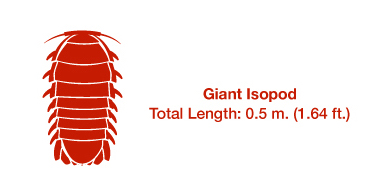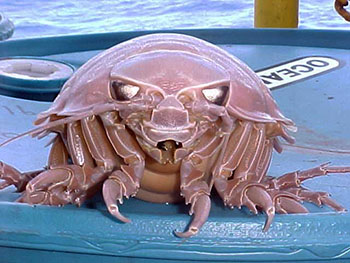 What I want to discuss, and I use this word specifically as after 10 years contemplation I seem no closer to an answer, is why the Giant Isopod is, well, giant?
What I want to discuss, and I use this word specifically as after 10 years contemplation I seem no closer to an answer, is why the Giant Isopod is, well, giant?
Mosely noted in 1880
Other [animals] attain under them gigantic proportions. It is especially certain crustacea which exhibit this latter peculiarity, but not all crustacea, for the crayfish like forms in the deep sea are of ordinary size. I have already referred to a gigantic Pycnogonid [sea spider] dredged by us. Mr. Agassiz dredged a gigantic Isopod eleven inches in length. We also dredged a gigantic Ostracod.
For over a 125 years, scientists have contemplated the extreme size of Bathynomus giganteus. Do other isopods attain these sizes? Gigantism is also known in the isopod Serolis but enlargement comes from flattening. B. giganteus appears unique in its extreme gain in bulk.
 Why the increase in size? Timofeev (2001) proposed that deep-sea gigantism, for all crustaceans, reflects colder temperatures leading to longer lifespans and thus larger sizes as these beasties continue to grow . However, despite little changes in temperature beyond the thermocline, deep-sea invertebrates including isopods continue to show changes in body size. Alternatively, Chapelle and Peck (1999 and 2004) demonstrated size was related to oxygen concentrations. It is suggested this relationship arises because the amount of oxygen available controls the amount of sustainable tissue. This has been shown experimentally in which cell size and cell number both increase with increasing oxygen concentration (Frazier et al. 2001). Larger sizes in snails are also found at more oxygenated sites in the deep sea (McClain and Rex 2001). However, giant isopods are known from the Gulf of Mexico deep where oxygen concentrations are low.
Why the increase in size? Timofeev (2001) proposed that deep-sea gigantism, for all crustaceans, reflects colder temperatures leading to longer lifespans and thus larger sizes as these beasties continue to grow . However, despite little changes in temperature beyond the thermocline, deep-sea invertebrates including isopods continue to show changes in body size. Alternatively, Chapelle and Peck (1999 and 2004) demonstrated size was related to oxygen concentrations. It is suggested this relationship arises because the amount of oxygen available controls the amount of sustainable tissue. This has been shown experimentally in which cell size and cell number both increase with increasing oxygen concentration (Frazier et al. 2001). Larger sizes in snails are also found at more oxygenated sites in the deep sea (McClain and Rex 2001). However, giant isopods are known from the Gulf of Mexico deep where oxygen concentrations are low.
Kevin Zelnio in an old post also brought up another interesting point….
B. giganteus is a scavenger (3, 5, 6), but some suggest it is also a facultative predator (3, 6). Specimens in aquaria have survived 8 weeks between feedings (5) and it speculated that this may be an adaptation for carrying its brood, which would be severely impacted by a full stomach (3). Further support for this hypothesis are the large quantities of lipid reserves in the hepatopancreas (14) and fat bodies (2) of this isopod.
 Alternatively, the larger size also increases fasting potential because greater fat reserves can be maintained. Larger size also confers a greater area for feeding, important for either a scavenger or a predator. Both of these are important adaptations in the food-limited deep sea.
Alternatively, the larger size also increases fasting potential because greater fat reserves can be maintained. Larger size also confers a greater area for feeding, important for either a scavenger or a predator. Both of these are important adaptations in the food-limited deep sea.
Of course all of this is speculative and it remains unclear why Bathynomus is unique among arthropods. Perhaps is size is simply a random walk in evolution and is nonadaptive. Gould noted in reference to another body size pattern, Cope’s Rule…
One would think that issues so fundamental, and so eminently testable, had been conclusively resolved long ago-except for a perverse trait of human psyche. We tend to pick most ‘notable’ cases out of general pools, often for idiosyncratic reasons that can only distort a proper scientific investigation
Is this case for the Giant Isopod? But perhaps the most interesting question is why the Giant Isopod is not larger?






Maybe there *are* larger isopods – either we just haven’t run across them (it’s not like we’ve thoroughly surveyed the abyssal plains – we haven’t), or, the people who have found The Big Ones were killed and eaten by the huge beasts before they could get word out. Either way, it is quite likely that we have not seen the biggest isopods Down There yet.